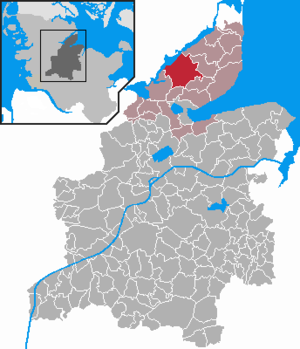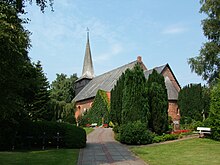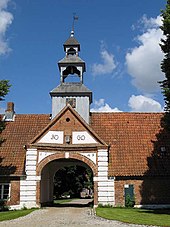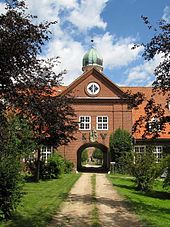Rieseby
| coat of arms | Germany map | |
|---|---|---|

|
Coordinates: 54 ° 33 ' N , 9 ° 49' E |
|
| Basic data | ||
| State : | Schleswig-Holstein | |
| Circle : | Rendsburg-Eckernförde | |
| Office : | Schlei Baltic Sea | |
| Height : | 30 m above sea level NHN | |
| Area : | 38.85 km 2 | |
| Residents: | 2710 (Dec. 31, 2019) | |
| Population density : | 70 inhabitants per km 2 | |
| Postal code : | 24354 | |
| Primaries : | 04355, 04358 | |
| License plate : | RD, ECK | |
| Community key : | 01 0 58 137 | |
| LOCODE : | DE 69O | |
| Office administration address: | Holm 13 24340 Eckernförde |
|
| Website : | ||
| Mayor : | Doris Rothe-Pöhls ( SPD ) | |
| Location of the municipality of Rieseby in the Rendsburg-Eckernförde district | ||
Rieseby ( Danish : Risby , Low German : Riesby ) is a municipality in the Rendsburg-Eckernförde district in Schleswig-Holstein .
geography
Rieseby is located on the Schwansen peninsula on the Schlei . The community has its center in the church village, which is about nine kilometers north of Eckernförde .
In the municipality, in addition to Rieseby, there are the villages of Norby (Danish Nordby ) with the expansion Norbyheide, Sönderby ( Sønderby ) with the expansion Vosskuhl and Drengberg, Basdorf ( Bastrup or Bostorp ) with moor wood , Kratt ( Krat ) and Hummelsweth ( Humleved ), Zimmert ( Simmert) ) with Boholm and Ulenholt as well as the goods Büstorf ( Bystorp ) with Holzhof, Sönderbyhof, Hörst ( Hørst ), Patermess ( Patermis ), Büchenau ( Bøgeaa ), Stubbe mit Stubberholz ( Stubbeholt ), Krieseby ( Krisby ) with Kriesebyau ( Krisbyaa ) and Saxtorf ( Sakstorp or Sakstrup ) with Legerholz. In addition, there are the smaller scattered settlements Buchholz ( Bøgholt ), Mührholm ( Myrholm ), Steckswiese, Neuwiese and Nordberg.
The community has a train station on the Kiel – Flensburg railway line .
history
Rieseby was first mentioned in 1352 in the registrum capituli slesvicensis and listed there as Rysbyharret ( Riesebyharde ). The place Rysebu was already mentioned in the registrum capituli of approx. 1407 , in 1641 one reads the names Riesebuy or Rießbuy on the swan map of the cartographer Johannes Mejer . It has not yet been determined when the spelling that is valid today has developed. The place name means roughly place in or on the bush . It is made up of the old Danish word ris (bush, forest) and by (village, settlement).
As one of the church locations on the south bank of the Schlei, which has probably been populated by Jutes and Angles since the 6th century , Rieseby was one of the most important settlements in the Eider-Schlei area. The late Romanesque brick church , which was built around 1220 and was presumably consecrated to St. Peter in Catholic times, is one of the most impressive monuments of the Waldemar era in the Schleswig region. This period, which lasted from 1150 to 1250, is named after the kings Waldemar I , Knuth VI. and Waldemar II .
The Schleswig Cathedral had several important properties in today's municipality. One of these possessions was Stubbe Castle in Jahnsholz, which was destroyed in 1417. It was later rebuilt at Gut Stubbe on a Schlei island across from Lindaunis .
In the later Middle Ages Rieseby was as Thingstätte meeting of Riesebyharde ( Rysbyharret ) and thus the peninsula Schwansen. The street name Dingstock (Danish Tingstok ) still bears witness to this today . The modern local coat of arms takes these references into account with its two motifs, the episcopal miter in the Schleswig colors and the dingstock .
In the 16th century the village of Rieseby was dissolved under the pressure of the expanding nobility and fell desolate, only the parish church remained. A settlement was only established in the 19th century. The free community was formed on the basis of a Prussian decree of March 29, 1876 and initially only included the villages of Rieseby, Norby and Basdorf with the associated extensions as well as the Hörst and Patermess farms.
The opening of the Kiel – Flensburg railway line in 1881 gave the place a great boost. In the following years several houses were built on Dorfstraße, including the dairy in 1891. Electric light was available from 1909. A significant expansion of the community area took place in 1928 through the connection of the previously independent manor districts of Büchenau, Saxtorf (with the exception of Erichshof and Charlottenhof), Stubbe (without the Guckelsby residential area) and Krieseby (without the Sieseby residential area).
politics
Local council, mayor
In the 2008 local elections, the CDU won nine out of a total of 17 seats. The SPD had five, the SSW two and the Greens one seat in the municipal council.
After the local elections in 2013, the SPD had seven seats, the CDU four, the newly founded Rieseby voter association, the Südschleswigsche voter association and Bündnis 90 / Die Grünen one each. The total number of seats should be reduced from 17 to 13 now due to the population. But since the SPD won all direct mandates, there were three overhang mandates. That is why the municipal council now had 16 seats. Accordingly, the SPD did not have an absolute majority, but provided Jens Kolls as the mayor for the first time in ten years. The SSW had founded a parliamentary group with Bündnis 90 / Die Grünen.
In the local elections on May 6, 2018, the CDU won four seats, the SPD five, the newly founded Rieseby Voting Association (WGR) six, Bündnis 90 / Die Grünen two and the Südschleswigsche Voters' Association one. One seat of the WGR was an overhang mandate, as the WGR had obtained six direct mandates. Since errors subsequently emerged in the allocation of the constituencies, the election on August 18, 2018 was declared invalid and a new election was set.
This new election was carried out on November 11, 2018, with the result: CDU three seats, the SPD five, the Rieseby voter community (WGR) eight, Bündnis 90 / Die Grünen two as well as the Südschleswigsche Voters 'Association and the newly founded Rieseby Citizens' Association (BVR) one each. Due to the eight direct mandates for the WGR, the municipal council has 20 seats.
coat of arms
Blazon : "Under a blue shield head, inside a golden bishop's cap with laterally swinging ribbons, in gold a decorated black thing stick in the form of an Antonius cross , each with a ring at the cross arm ends."
The bishop's hat symbolizes that the area around Rieseby was owned by the diocese of Schleswig before the Reformation . The dingstock in the form of an Antonius cross refers to the medieval Thingstätte in the Rieseby area.
Partner communities
- Süderholz in Mecklenburg-Western Pomerania : The partner contract initially existed with the municipality of Rakow. In 1999 this united with other parishes. The partnership with the newly formed Süderholz community has existed since then.
- Ravsted in Denmark
Culture and sights
In Norby is the Anna mill, which was moved from Westerhever to Norby in 1911 and built there. Today the mill site is owned by the Rieseby community and is maintained by a local community. The mill houses a local museum, which also includes the old sawmill and the outdoor area with a Göpelschuppen . The exhibition area inside the mill extends over several floors with a total of over 2000 exhibits to be viewed. The entrance area with the wedding room is furnished in an antiquarian fashion, a room that is also used for weddings and events. Right next to the mill Anna, in the villa-like former miller's house, is the studio in the mill house , a small artist's studio .
Good stub
Gut Stubbe is located near the Lindaunis Bridge .
Good Saxtorf
The aristocratic Saxtorf estate (Danish: Saxtorp , Sakstorp or Sakstrup , Low German: Saxdbod ) was established in the 16th century. The manor of Saxtorf and the place name itself, however, are considerably older. The place name Saxtorf was first mentioned in writing in 1499 and is composed of -torf for village ( adän. Thorp , mnd. Dorp ) and sax . The latter part of the name goes back to the nickname Saxi or Sakse , which in turn can be traced back to the tribal name of the Saxons or to the homonymous appellative for knife, sword . The place name was adopted before the disappearance of the Danish dialect in Schwansen in the 16th and 17th centuries and before the transition from ks to ws in South Jutland into Low German .
At the end of the 15th century, Saxtorf was owned by the Wohnsfleth family, a knightly family. In 1494 the knights of Blome acquired Saxtorf. Hinrich Blome built the estate on schedule, but the Ahlefeldt family acquired the property as early as 1500 . It remained in the possession of the Ahlefeldts until 1566. By marriage, the estate came to the Rantzau family , who managed it until 1633. Once again through marriage it fell back to the von Ahlefeldt family. In 1690 the von Brockdorffs acquired the estate, in 1741 the von Ahlefeldt family again came into possession of Saxtorf. In 1648, Cai von Ahlefeldt built an impressive baroque manor house in French style . On Christmas Day 1847, this building burned down to a large extent. A remnant of the house was integrated into the new building completed in 1852.
After the death of Carl F. G. von Ahlefeldt, the property fell entirely from the family. N. G. Gülich from Berlin then bought Saxtorf for one million marks. Nevertheless, the owners of Saxtorf changed constantly. In 1919 Peter Hoff from Olufskjer bought the estate, and since then the property has remained in the Hoff family. In 1955 his son Johann Ludwig Hoff was the owner, then his nephew Bernd Hoff-Hoffmeyer-Zlotnik, son of his sister, whom he adopted in 1969.
The Hamburg architect Friedrich Stammann planned this new building in the then fashionable design language of neo-Gothic (neo-Gothic) as a three-wing complex. A centrally arranged, five-story tower emphasizes the symmetry of the complex. At the end of the 1970s, the estate was used as a "scottish haunted castle" for a ZDF crime series commissioned by Madame . The Studio Hamburg produced in 1984 on behalf of the NDR , the Siegfried Lenz - Novelle One end of the war and used the estate as a film location.
Good Krieseby
The Krieseby estate is located between Rieseby and Sieseby. The place and noble estate were first mentioned in the 15th century . The gatehouse dates from 1749, the horse stable from 1747. In the park there is an oak tree that is over 800 years old.
The first owners are the Ritter Breide, followed by the Wohnsfleth, Otte, von Ahlefeld and, since 1847, Kühl families.
Good listen
The merchant Carl Illies (1840–1910) acquired the property, his son Rudolf (1877–1920) had the house expanded and a reform garden from the early 20th century laid out by the Kiel garden architect Clemens Jelin (1868–1936). Today the estate belongs to the Claussen family.
Personalities
- Johann Rudolf Christiani (1761–1841), German educator
- Christian Kock (1867–1949), German homeland researcher
See also
literature
- Henning v. Rumohr: Castles and mansions in the Duchy of Schleswig. rework. by Cai Asmus v. Rumohr, Verlag Weidlich, Würzburg 1987, 3rd edition, ISBN 3-8035-1302-2 , p. 257.
- Deert Lafrenz: manors and manors in Schleswig-Holstein. Published by the Schleswig-Holstein State Office for Monument Preservation, Michael Imhof Verlag, Petersberg 2015, 2nd edition, ISBN 978-3-86568-971-9 , p. 501.
Web links
Individual evidence
- ↑ North Statistics Office - Population of the municipalities in Schleswig-Holstein 4th quarter 2019 (XLSX file) (update based on the 2011 census) ( help on this ).
- ↑ Gerret Liebing Schlaber: Administrative tilhørsforhold mellem Ejderen og Kongeåen indtil 2007 , Flensburg / Flensborg 2007, p. 258
- ^ M. Mørk Hansen, CL Nielsen: Kirkelig Statistics on Slesvig Stift med historiske og topografiske bemærkninger. Volume 3, Kjøbenhavn 1864, p. 349
- ↑ Gerret Liebing Schlaber: Administrative tilhørsforhold mellem Ejderen og Kongeåen indtil 2007 , Flensburg / Flensborg 2007, p. 258
- ^ M. Mørk Hansen, CL Nielsen: Kirkelig Statistics on Slesvig Stift med historiske og topografiske bemærkninger. Volume 3, Kjøbenhavn 1864, p. 349
- ^ Hector Boeck: Sydslesvig , København 1953
- ↑ Johannes Kok: Det danske folkesprog i Sønderjylland , Volume 2, København 1867, p. 333
- ^ M. Mørk Hansen, CL Nielsen: Kirkelig Statistics on Slesvig Stift med historiske og topografiske bemærkninger. Volume 3, Kjøbenhavn 1864, p. 350
- ↑ Wolfgang Laur: Historisches Ortnamelexikon von Schleswig-Holstein , 2nd edition, Neumünster 1992, p. 545
- ^ M. Mørk Hansen, CL Nielsen: Kirkelig Statistics on Slesvig Stift med historiske og topografiske bemærkninger. Volume 3, Kjøbenhavn 1864, p. 349
- ^ Minutes of the determination of the result of the municipal election on May 25, 2008. (PDF) In: amt-schlei-ostsee.de. Retrieved November 12, 2018 .
- ↑ Minutes of the declaration of the result of the municipal elections on 05/26/2013. (PDF) In: amt-schlei-ostsee.de. Retrieved November 12, 2018 .
- ↑ Record of the determination of the result of the municipal election on May 6, 2018. (PDF) In: amt-schlei-ostsee.de. Retrieved November 12, 2018 .
- ^ New elections in Rieseby. (PDF) In: Schlei-Blättchen Rieseby. Retrieved November 12, 2018 .
- ↑ Record of the determination of the result of the municipal election on 11.11.2018. (PDF) In: amt-schlei-ostsee.de. Retrieved November 12, 2018 .
- ↑ Dirk Steinmetz: WGR wins the local election clearly ahead of the SPD. In: shz.de. Retrieved November 12, 2018 .
- ↑ Schleswig-Holstein's municipal coat of arms
- ↑ Mill Anna and studio in the mill house
- ↑ Wolfgang Laur: Historisches Ortsnamelexikon von Schleswig-Holstein , 2nd edition, Neumünster 1992, p. 566
- ↑ Johannes Kok: Det danske folkesprog i Sønderjylland , Volume 2, København 1867, p. 333









